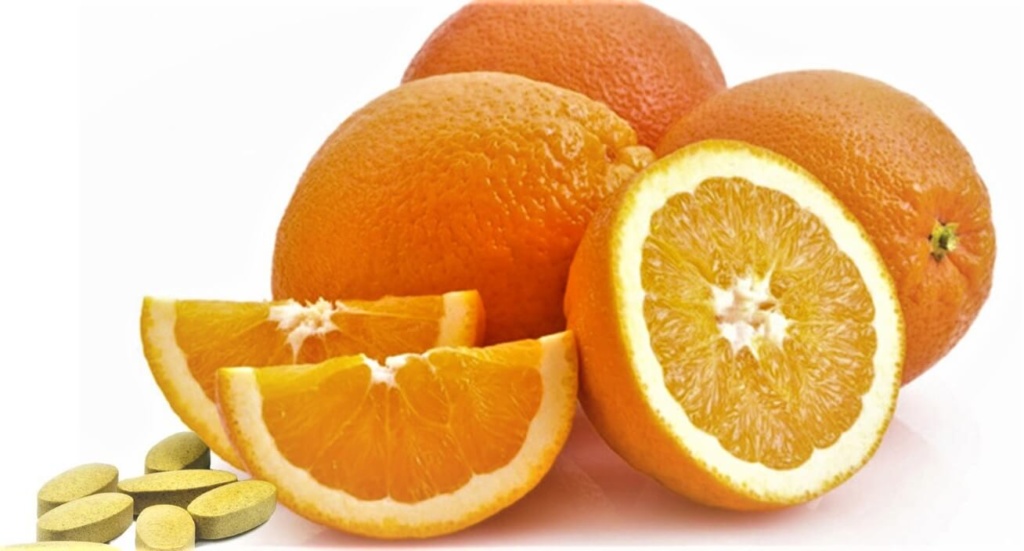Vitamin C is a water-soluble vitamin. It is necessary for normal growth and development.
The water-soluble vitamins dissolve in water. The excess amounts of the vitamin leave the body through the urine. Although the body maintains a small reserve of these vitamins, they must be taken regularly to avoid a shortage in the body.

Features
Vitamin C is needed for the growth and repair of tissues in all parts of the body. Is used for:
- Form an important protein used to make skin, tendons, ligaments, and blood vessels
- Heal wounds and form scar tissue
- Repair and maintain cartilage, bones and teeth
- Help the absorption of iron
Vitamin C is one of many antioxidants. Antioxidants are nutrients that block some of the damage caused by free radicals.
- Free radicals are produced when the body breaks down food or when you are exposed to tobacco smoke or radiation.
- Free radical accumulation over time is largely responsible for the aging process.
- Free radicals can play a role in cancer, heart disease, and disorders like arthritis.
The body cannot make vitamin C on its own, nor does it store it. Therefore, it is important to include many foods that contain this vitamin in the daily diet.
For many years, vitamin C has been a home remedy for the common cold.
- Research shows that, for most people, vitamin C supplements or foods rich in vitamin C do not reduce the risk of getting the common cold.
- However, people who take vitamin C supplements regularly may have slightly shorter colds or somewhat milder symptoms.
- Taking a vitamin C supplement after a cold starts doesn’t seem to work.
It may interesst you:the 12 best foods to boost immune system
No one doubts that vitamin C is essential for the proper functioning of human physiological processes. This compound whose chemical name is ascorbic acid intervenes in a multitude of vital processes and functions and its prolonged absence in the diet can lead to syndromes such as scurvy, a disease that can be fatal.
Scurvy was found above all among sailors who spent long periods at sea without trying either fruits or vegetables , since they are the only natural sources of vitamin C. On the other hand, since it is practically present in all of these foods In normal situations, it is very difficult to suffer from a vitamin C deficiency, so cases of deficiency disease are very rare.
However, this same almost omnipresent presence of ascorbic acid in the plant world belies one of the great myths of western breakfast: that orange juice is the best source of vitamin C to start the day. While it is true that natural fruit juices are surely more appetizing in the morning than a salad, a vegetable or a whole piece of fruit, it is not less so, since their contribution in free sugars makes them inadvisable, at least in children.
Therefore, it is worth mentioning that we can do without them, or replace them with a piece of whole fruit, since throughout the day, if we attend to a healthy and balanced diet, we will acquire the necessary daily amount of vitamin C, which is between 40 and 100 milligrams (mg), according to the WHO , from many other sources, always vegetables.

To give you an idea of what are some of the fruits and vegetables that can more than fill our daily demand for vitamin C, here are 10 natural foods that contain 100 grams more ascorbic acid than oranges, which provide about 50 milligrams for every 100 grams. If we opt for them throughout the day, we will also reduce the intake of sugars and increase in return the intake of vegetable fiber , a fundamental compound for the good health of our intestinal flora and to keep obesity, diabetes and cardiovascular diseases away.
1. Red peppers:
Red peppers have 139 mg of ascorbic acid for every 100 grams of product, as long as they are eaten raw, since heat destroys a good part of vitamin C. There are those who cannot bear their taste, who add them to salads, and who eat directly into bites.
2. Parsley
This spice herb has 133 mg of ascorbic acid per 100 grams . It can be added to the salad or prepared in cous-cous with a splash of lemon.
3. broccoli
It has 110 mg of ascorbic acid per 100 grams , as long as it is eaten raw. It can be added to cold soups, in salads or as a veggie to slice sauces, hummus or baba ganoush.
4. Kiwi
It has 100 mg of ascorbic acid per 100 grams ; It can be an excellent breakfast juice substitute for orange juice. Furthermore, its high fiber content gives it laxative power.
5. Fennel bulb
It has 93 mg of ascorbic acid per 100 grams . It is usually used in julienne-carried salads, although for its somewhat sweet flavor it is sometimes presented in a separate dish sprinkled with orange juice.
6. Grape
Although its percentage of sugars is high, its 90 mg of ascorbic acid per 100 grams and its vegetable fiber make them interesting as a source of vitamin C.
7. Strawberries
They offer 70 mg of ascorbic acid per 100 grams of product. They are another appetizing substitute for morning juice or an ideal dessert, yes: no added sugar.
8. Basil
Its 61 mg of ascorbic acid per 100 grams make them a good addition to salads, albeit measured, since its flavor is strong and not everyone likes it.
9. Persimmon
Taking advantage of the season of persimmons or rosewoods, mention that they give away 60 mg of ascorbic acid per 100 grams , so it is a good idea to take advantage and buy them at the fruit store.
10. Papaya
Being a fruit more or less present in our markets, although still expensive, it is worth highlighting its 60 mg of ascorbic acid per 100 grams.
Tell us what topics interest you
At Buzzrecipes we are focused on informing you of what interests you and, therefore, we want to open a channel so that you can communicate with us and guide us about your preferences. If you want us to investigate or talk about a specific topic, you can write to us.
don’t miss :What foods are rich in vitamin C?
